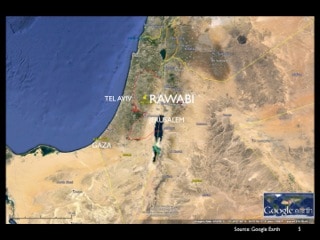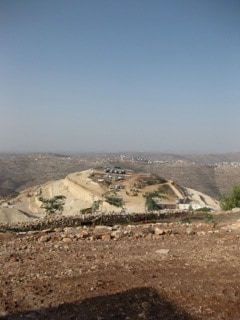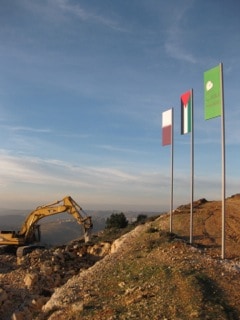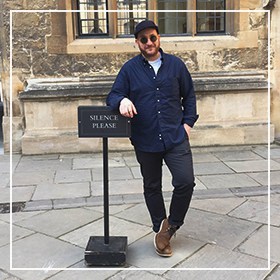Since 2007, the Palestinian government in the West Bank has been working to build a state while under occupation. Already almost entirely dependent on international aid and shedding many of its responsibilities to its citizens, the putative state increasingly and officially emphasizes private investment and privatization over public service.
Analysis of this state in the making, this state that may never emerge, can provide insight into the ways that private developers are profiting in previously unprofitable markets and territories. And how aid, governance, and everyday life form in relation to those imperatives and the ideas that circulate to justify and establish them.
More specifically, I ask: how does the government and private sector’s stated “national priority to develop affordable housing” help establish new markets in housing and finance in the West Bank. How does an abstract priority orient practice? In a state that is perpetually in a condition of becoming, NGOs, developers, and the government produce documents and statistics that provide evidence, make claims about the present, and presuppose a future they help ensure.
The government, donors, and the private sector come together to create large-scale development that claims to meet needs for housing. Developments that physically anchor political economic transformations, alter the landscape, and incorporate ordinary Palestinians into a wider vision for the future. And set precedents for future interventions and investment.
More specifically, the government acts as a conduit for aid to reach the private sector, and alters laws such as those regulating land tenure and tenants’ protection. Aid agencies and donors back development and finance projects in order to minimize risk for Palestinian investors. “Middle class” Palestinians enter into projects as consumers in new markets for housing. Markets that did not exist prior to large development, and with forms of financing that could not exist prior to reforms in land tenure and foreclosure laws.
The Palestinian Authority, donor institutions, and Palestinian capitalists have differences, but they share two goals: to make Palestine stable and profitable.
 At different times between 2008 and last year, I conducted field research on privatization in the West Bank, where I focused on Rawabi, a massive new planned town under construction 9 km north of Ramallah, and mostly funded by Qatar. The idea for Rawabi began to take shape in 2004 in order to meet needs for housing, and eventually it is supposed to house 40,000 “middle class” Palestinians. No one lives there yet.
At different times between 2008 and last year, I conducted field research on privatization in the West Bank, where I focused on Rawabi, a massive new planned town under construction 9 km north of Ramallah, and mostly funded by Qatar. The idea for Rawabi began to take shape in 2004 in order to meet needs for housing, and eventually it is supposed to house 40,000 “middle class” Palestinians. No one lives there yet.
Rawabi is a massive, visible indication that Palestine is moving towards private development and governance. It quickly became a topic of conversation well before there was any Rawabi to speak of. It’s constantly in the local and international news. The highest levels of Palestinian and Israeli government continuously negotiate over its specifics, its road, its water hookup, and so on. The resources, the land, the political capital it marshaled are unprecedented there, as are the changes it enables and forces in its wake.
The context for state building
West Bank Palestinians’ relationship to Palestine substantially changed after the 1993 Oslo Accords. The PLO leadership returned from exile in Tunis and elsewhere. In 1994, the Palestinian National Authority, the PA, formed for an interim term of five years, during which time negotiators would iron out the “final status” issues of borders, settlements, Jerusalem, and Palestinian right of return. Today of course the PA still exists and final status issues are unresolved. First of all, Oslo created the idea of a Palestinian interim government operating with meaningful sovereignty coming at some later date. Second, it carved the West Bank into three areas of territorial control: Area A, where Palestinians have civil and military control. Area B is under Palestinian civil and Israeli military control. And the rest, more than 60% of the West Bank, is Israeli-controlled area C.
In 2007, Salam Fayyad, formerly of the International Monetary Fund (IMF), became Minister of Finance partially at the behest of donor countries. Later that year, the two largest political factions, Fatah and Hamas, split. After a Hamas legislative victory, ongoing tensions became open hostility in both the West Bank and Gaza, and the Palestinian President Mahmoud Abbas dissolved the unity government and appointed Fayyad Prime Minister.
The split and Fayyad’s ascendance were the basis for new kinds of pro-privatization initiatives in the West Bank by establishing Fayyad as the ideological center of government, and narrowing the government’s focus to the West Bank. Fayyad focused on privatization and reform at the scale of the West Bank. He established an economic agenda based on the need for profit, and worked towards a national economy that would encourage stability, investment, and ultimately the state
Rawabi is the marquee project and important precedent for ongoing state and economy building projects, and it demonstrates the way the two are intertwined, mutually-produced, and inseparable.
Palestine is an alphabet soup of ministries, NGOs working in the public interest, NGOs working narrowly for private interests, International NGOs, and so on. And they all constantly produce reports. Development in Palestine is now focused explicitly on growth and privatization. This means a partial shift from public works, municipal projects, cultural centers, and so on, towards aid to private developers.
Palestine is both circumscribed and almost entirely dependent on foreign aid. Any reformulation of how capital enters and what it is supposed to do has enormous consequences. And ideologies and practices formed at the scale of the state and international organizations touch the ground in places like Rawabi.
The PA, the private sector, the Palestine Investment Fund, UN HABITAT, the pro-free market think tank Portland Trust, and others, proposed a “national priority to develop affordable housing” in order to meet demand in a context of a housing shortage. This coalition of actors suggests that there is a need for something like 500,000 housing units in the West Bank over the next decade. So housing is a national priority, elaborated by the PA and representative coalitions of large developers. Why is it a priority? And what needs to happen to accomplish such a priority?
The question of priority
There is some dispute about whether or not there is enough need among Palestinians for housing to be a national priority: a member of the Higher Planning Council questioned the idea of a housing shortage. “It is important,” they said, for the private sector “to eradicate critical analysis…I can find a house in 24 hours if needed.”
According to that official, there may be a deficit, but it is nowhere near the numbers that developers cite. Does it mean that people will move to Ramallah rather than commute? Is it a rural/urban problem? It is at best “approximate.” And he notes that building patterns around Ramallah exist because of, and in response to, the current normal conditions of military occupation, Israeli control over the majority of the West Bank, and closure. If this is true, what are the “national priorities” here? And what does the national priority mean for the polity?
Banks in Palestine typically do not grant long-term loans for two reasons. The first is that political and economic instability make them reluctant to tie up large amounts of money in loans. And Palestinians are reluctant to take on long-term debt. The social preference is to save and to build on existing houses. The second reason is that land tenure is very complicated, and plots of land can be held collectively. Without clear title, land can’t be used for collateral. But clear titling is difficult: PA law, Israeli civil or military law, Jordanian law from 1967, or Ottoman law can govern what happens in certain places.
 So the government stepped in to solve this problem for developers.
So the government stepped in to solve this problem for developers.
Developers bought a patchwork of land where they wanted to put the new town. They bought lands from surrounding villages, and supposedly they sent teams out into the diaspora. In Jordan, Lebanon, Latin America, Dearborn they tracked down the families and individuals who owned that land. The government then did a fairly large land reparcelization/eminent domain to tie together the land beneath the site’s footprint. Typically, eminent domain must meet “the public good.” This is the first time the Palestinian government did eminent domain for a private entity.
As a result, land on a large scale has clear title, apartments can be collateral, and a mortgage market can emerge. And, as I understand it, the eminent domain happened using a rush provision in the Jordanian Law. The Palestinian Land Authority set up a fund to pay out people who had their land seized, and notified them. Compensation was based on prices in the area pre-speculation and development. Owners had two choices: they could take the money, or they could file a complaint. Either way their land was already a part of Rawabi.
Ideas circulate at the scale of government and reach the ground: priorities are materialized, and inflect everyday life and change the way people hold and use their own land.
Is it a state?
In “Notes on the Difficulty of Studying the State,” Philip Abrams contrasts the state-system, the institutions and practices of government; and the state-idea, the state’s “symbolic identity.” He urges a focus on the state as a mechanism of political subjugation, or in Engels’ terms, “the first ideological power over man” (Abrams 1977:64). The state is nevertheless ambiguous. It was in 1977, and it remains so today. Abrams proposes abandoning questions about the state’s reality in favor of a focus on the idea of the state, and more specifically, the state as an ideological project, and the idea of the state under capitalism.
The ongoing process of state building in Palestine is an attempt to create the idea of the state and fabricate a state system around it. Through practice, a state system emerges in the form, and in terms of the precedents of, the state idea.
The state is important, but its dimensions are less important than the ways it is productive. How is such a state, an administrative system under occupation linked to the global economy? To Israel?
On the one hand, the PA and Palestinian capitalists say they are building a state, and I argue that by producing and orienting practice around the idea of the state, they are succeeding in terms of state scale systems of economic practice, markets, and in terms of what Lefebvre has called the state mode of production, and the importance of a state for organizing space in order to ensure forms of capitalist accumulation. But this is also a truncated state, a set of administrative institutions, in a territory long subject to colonization and stabilization attempts, and born from the context of colonial violence.
 But this is not only an abstract question. People are linked to economic and political phenomena at distant scales. Ideas circulate globally, and touch the ground in specific places with specific forms. Following the anthropologist Janet Roitman, the relationships between citizen and subject are mediated not only by regulatory regimes and fiscal institutions within states, but through regional political economies, shifting laws, institutions, infrastructures and mobility. Practices at different and multiple geographic scales make important contributions to “national” and state political economy. Moreover, sovereignty and state form around questions of global capital. A state is being purpose-built to organize accumulation in ways specific to Palestine, but consonant with the ways that states are part of local accumulation strategies and integration into world markets generally and as part of a global network of nation-states.
But this is not only an abstract question. People are linked to economic and political phenomena at distant scales. Ideas circulate globally, and touch the ground in specific places with specific forms. Following the anthropologist Janet Roitman, the relationships between citizen and subject are mediated not only by regulatory regimes and fiscal institutions within states, but through regional political economies, shifting laws, institutions, infrastructures and mobility. Practices at different and multiple geographic scales make important contributions to “national” and state political economy. Moreover, sovereignty and state form around questions of global capital. A state is being purpose-built to organize accumulation in ways specific to Palestine, but consonant with the ways that states are part of local accumulation strategies and integration into world markets generally and as part of a global network of nation-states.
Moreover, interventions like housing developments are physical places, not just ideas and forms of investment. They tie together people and ideas and structures of government through the state project. They tie together actual Palestinians and material, physical objects.
Housing is intimate—it brings families and everyday life into the wider vision. Whether or not housing developments expand or a state emerges, this broad suite of changes to the economy, aid, and governance includes aspects that might forever alter how Palestinians live in their homes and their homeland.
This post is based on a longer talk, “Palestine’s shifting priorities: how private development is transforming aid, governance, and daily life in the West Bank”. All photos except the header image are courtesy of the author.







